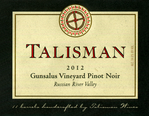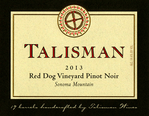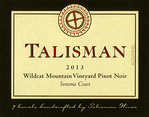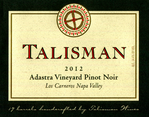| Scott and Marta Rich launched Talisman in 1993, with just 204 cases of Madonna Vineyard Pinot Noir. They continued with only one Carneros bottling until 1999 when they expanded with a Russian River offering from Klopp Ranch - thanks to Merry Edwards, who offered them a share of that vineyard until her program grew. In 2001 their third wine came from Thorn Ridge, a fabulous site on the north edge of the Petaluma Gap on the Sonoma Coast. Soon thereafter Steve MacRostie approached them with the idea of a Talisman Pinot Noir from his very unique Wildcat Mountain site. Adastra vineyard joined the family with the 2005 vintage and Talisman was off to the races, adding a new vineyard every year or two to expand their offerings. In 2012 they finally crested 2000 cases. Their cuvées are typically 100-300 cases, though in recent vintages they've had a lot of fun crafting many tiny bottlings of specific vineyard blocks, clones or winemaking techniques. They continue to stay small and grow slowly, as they find vineyards of interest, with unique site characteristics and the potential to convey distinctive and singular terroirs. Talisman’s goal is very simple: the creation of exquisite Pinot Noirs that are true to their roots and accurately reflect their places of origin. Scott Rich attended graduate school in the enology program at U.C. Davis and has worked as a research enologist for both RH Phillips and Robert Mondavi. He has been winemaker at Mont St. John, Carneros Creek, and Etude, where he made highly-acclaimed Pinot Noir and Cabernet. Currently, Scott's time and energy are spent as winemaker/owner of Talisman, as well as winemaker for Moraga Vineyards in Bel Air, California. Moraga produces sought-after Cabernet Sauvignon and Sauvignon Blanc. Marta Rich actually has no memory of life without wine. Her father made wine in their Minnesota basement, using virtually any form of grapes or juice he could get. Yearning for warmer climes and more interesting terrain, Marta fled for the University of Colorado at Boulder, where she earned her degree in Psychology. After taking up residence in Napa Valley, Marta began an 18-year stint at Robert Mondavi. She worked her way up the ladder, first scheduling grapes during harvest and eventually running Mondavi's Northern California sales team. She was well-prepared for both of her current jobs, Director of Sales for Calera Wine Company, one of California's Pinot Noir pioneers, and Director of Sales & Marketing for Talisman Wines. About the name: Scott's American Indian mother (an Arizona native) once gave him a special charm or talisman, that had been made and blessed by a medicine man. One of the elements of this talisman was the medicine wheel. This is now Talisman's logo. The elements of the medicine wheel represent the circle of life and the four directions, reminding us of our place in the universe. The rays around the wheel represent the sun, which provides energy for life on Earth and ripens grapes, allowing us to revel in the pleasure of life, including fine wine. Sustainability: Talisman ditched the capsules to be more eco-friendly. They buy their boxes from a solar-powered company, and recycled an old labeling machine from Jaboulet. |
| Talisman Website |
 |
| Pinot Noir Gunsalus Vineyard – Sonoma Coast |
| Pamela and Glen Gunsalus (“gun-say-lus”) are always in their vineyard, planted in 2001 and located on a west-facing slope in the Green Valley of Russian River Valley appellation. These two former researchers have great intuition backed up by scientific rigor and it shows in the quality of their grapes. The vines are from Dijon clones 114, 115, and 777. 2012 was the poster child vintage for great conditions in the vineyard. The first of several years of serious drought provided reasonably moist soils for budbreak in March and flowering in late May. A moderate crop was the result of dry, mild weather during flowering and fruit set. Supreme weather dominated for the balance of the growing season into harvest, with an absence of any remarkable heat waves or unusually cold weather. Most of Gunsalus Vineyard was picked September 8th, Talisman's first harvest of the year. The balance of the grapes were picked September 15th. Both fermentations included a whole cluster component of about 25%. After fermentation and post-fermentation maceration, both lots were combined post-pressing and aged in François Frères, Dargaud et Jaegle, Marcel Cadet, Rousseau, and Remond barrels, where the wine underwent malolactic fermentation. The wine was racked after 20 months in barrel (64% new French oak) and blended just prior to bottling. The 2012 Gunsalus Pinot Noir is a bright, vibrant, and beautifully integrated wine. The aroma is broad, dense, and slightly brooding, and woven with threads of sweet dark cherry, sarsaparilla, gingerbread, tobacco, dark spice, and red licorice. The palate is lively and the texture is rich, silky and sexy; playing well with black cherry, cedar, and mixed dark berry flavors with a hint of cinnamon. This toothsome wine finishes with fine-grained tannins and a bit of black pepper on the finish. 14.6% alcohol. 267 cases produced. |
 |
| Pinot Noir Red Dog Vineyard – Sonoma Mountain |
| Located high on the northwest flank of Sonoma Mountain, this panoramic mountainside site is the recipient of coastal fog and cool air flowing from the chilly Pacific through the Petaluma Gap and slamming directly into the upper reaches of Sonoma Mountain. The soils are low-vigor loamy clays, thus the grapes on this site ripen very slowly, providing perfect conditions for complete and complex flavor development. Fog often persists in the mornings when the sun has risen above the eastern slope and by the time the afternoon sun has made its impact on the western slope, the cold air and fog begin their journey back from coast to mountain. "Because we’re in California, we’re often blessed with beautiful weather for grape growing and a relative lack of serious challenges during the growing season. Even under favorable conditions, which we had in 2013, success still requires great management practices in the vineyard and we could not have made such nice wine without well executed and timely work in the vineyard." Both the west-facing slope planted to Pommard clone and the east-facing slope planted to Dijon clones 115 and 777 were picked on September 18. Despite dropping lots of fruit on the ground at veraison to ensure even ripeness and flavor development, the crop was a bit larger than most, although that’s all relative, given that in some years the crop load at Red Dog was not much more than 1 ton per acre. The Pommard clone was fermented on its own in a 5-ton open top fermenter. The Dijon clones were fermented in small 1-ton fermenters, both solo and co-mingled. After indigenous yeasts fermentation, all of the lots underwent an extended maceration before pressing and barreling. This bottling is predominantly Pommard with some Dijon 777 and a smattering of Dijon 115 thrown into the mix. It was aged for 19 months in French oak barrels - 62% new. This wine has a remarkably complex nose, loaded with some of the aromas one usually only hope for; a great balance of plum, cherry, and strawberry played against rose petal and the comforting smell of a damp redwood forest. The wine is lush, rich and texturally elegant with noticeable persistence. 14.4% alcohol. 413 cases produced. |
 |
| Pinot Noir Wildcat Mountain Vineyard – Sonoma Coast |
| Situated high on the southern flank of the mountain range defining the western edge of Sonoma Valley, Wildcat Mountain Vineyard is an outlier relative to any other vineyards in the area. The highest vineyard in the appellation at an elevation of 750’, it sits on well drained rocky soils of volcanic origin, exposed to the full brunt of fog and cold airflow that streams off the upper reaches of San Pablo Bay. This is an ideal place to grow top-tier Pinot noir grapes. Formerly grazing land, the vineyard was established by Nancy and Tony Lilly with their partner, Steve MacRostie in 1998. The quality of the vineyard bears testimony to the vision and tenacity of several generations of Nancy's family, which has been the steward of this land since 1940. It’s wonderful to talk about vintages that are so even-keeled and lack heroic challenges The second year of drought, 2013 was characterized by easy weather, a moderate growing season, and a fairly large crop that was tamed by dropping a painful amount of fruit on the vineyard floor at veraison. All three blocks were picked September 22 and co-fermented in a single fermenter after sorting and gentle destemming. The whole cluster component was about 25%. The balance of the winemaking consisted primarily of thinking long and hard about how to meddle as little as possible on the way from getting the wine from the fruit stage into the bottle – a bit of a soak prior to indigenous fermentation (both primary and malolactic), punch downs for cap management, extended maceration, and then barreling for 19 months with 57% new French oak. The wine eschewed racking until it was moved to tank prior to bottling. This is probably the finest example that Talisman has produced from this vineyard and it is full of classic Wildcat Vineyard aromas and flavors. It’s pretty and spicy, redolent of crushed berries mingled with mineral, mushroom, and forest floor. The mouth is lush and concentrated with black cherry, blackberry, stone fruit, exotic spices, cola, mineral, and dried orange peel. On the palate, it is rich and round with soft tannins and a lengthy finish. 14.2% alcohol. 164 cases produced. |
 |
| Pinot Noir Adastra Vineyard – Los Carneros |
| Adastra is a California Certified Organic vineyard planted in 1994 and situated in the very heart of the Los Carneros appellation. Located in a low spot with cool air flow and very thin, relatively light clay-loam soils, it is a site with naturally low vigor. The inherently low yields produce extraordinary fruit from vines that require little in the way of manipulation, a hallmark of an exceptional vineyard. Chris Thorpe and his son-in-law Edwin Richards do an incredible job of managing this vineyard that produces wines unlike most Los Carneros Pinot noirs. The 2012 vintage was ideal; budbreak occurred right on schedule in March and the weather was dry and mild during flowering and fruit set, producing a moderate crop. Supreme weather dominated for the balance of the growing season into harvest, with an absence of any remarkable heat waves or unusually cold weather. The grapes were picked at optimum ripeness, and all blocks were harvested in a single day. In addition to the blocks thatTalisman has historically sourced, they also worked with the first significant crop from four new blocks containing “suitcase” clones that had been budded over from Merlot to Pinot Noir. The largest lot produced was a co-fermentation of several clones in a 5-ton open top fermenter; Talisman also fermented a couple of the clones separately in smaller fermenters; 25% whole cluster fruit was included in these fermentations. Indigenous fermentation started 4-5 days after harvest and all of the lots underwent extended maceration prior to pressing and barreling. The different lots were blended just prior to bottling. The wine was aged for 20 months in François Frères, Dargaud et Jaegle, Marcel Cadet, Cadus, and Remond barrels - 59% new oak. The bouquet is a deep, well-integrated symphony of notes – licorice, black cherry with vanilla custard, a hint of briar, hay, and redwood bark. The flavors are bold, and comforting nips of raspberry, cherry, and dark plum yield to spicy cranberry on the mid-palate. The texture is built of silky tannins and the finish lingers and lingers. 14.4% alcohol. 416 cases produced. |
| Printer Friendly Version |
| Copyright © 2002-2017 VOS Selections, Inc. |